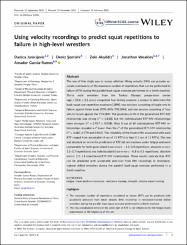| dc.contributor.author | Janicijevic, Danica | |
| dc.contributor.author | Şentürk, Deniz | |
| dc.contributor.author | Akyıldız, Zeki | |
| dc.contributor.author | Weakley, Jonathon | |
| dc.contributor.author | Garcia-Ramos, Amador | |
| dc.date.accessioned | 2024-03-13T21:15:50Z | |
| dc.date.available | 2024-03-13T21:15:50Z | |
| dc.date.issued | 2024 | en_US |
| dc.identifier.issn | 1746-1391 | |
| dc.identifier.issn | 1536-7290 | |
| dc.identifier.uri | https://hdl.handle.net/11363/7199 | |
| dc.description.abstract | The aim of this study was to assess whether lifting velocity (MV) can provide accurate estimations of the maximum number of repetitions that can be performed to
failure (RTF) during the parallel back‐squat exercise performed in a Smith machine.
Thirty male wrestlers from the Turkey Olympic preparation center
(age = 22.6 � 2.2 years) completed four testing sessions: a session to determine the
back‐squat one‐repetition maximum [1RM], two sessions consisting of single sets to
failure against three loads (90%‐80%‐70%1RM), and one session consisting of four
sets to failure against the 75%1RM. The goodness‐of‐fit of the generalized RTF‐MV
relationship was strong (r
2 = 0.838), but the individualized RTF‐MV relationships
were stronger (r
2 = 0.957 � 0.058). Only 3 out of 60 individualized RTF‐MV relationships revealed a r
2 lower than the r
2 of the generalized RTF‐MV relationship
(r
2 = 0.685, 0.779 and 0.810). The reliability of the fastest MV associated with each
RTF ranged from acceptable (4 out of 15 RTFs) to high (11 out of 15 RTFs). The raw
and absolute errors in the prediction of RTF did not increase under fatigue and were
comparable for both generalized (raw errors: −1.0–0.3 repetitions; absolute errors:
1.1–1.7 repetitions) and individualized (raw errors: −0.8 to 0.1 repetitions; absolute
errors: 1.2–1.8 repetitions) RTF‐MV relationships. These results indicate that RTF
can be predicted with acceptable precision from MV recordings in resistance‐
trained skilled wrestlers during the parallel back‐squat exercise performed in a
Smith machine. | en_US |
| dc.language.iso | eng | en_US |
| dc.publisher | TAYLOR & FRANCIS LTD2-4 PARK SQUARE, MILTON PARK, ABINGDON OR14 4RN, OXON, ENGLAND | en_US |
| dc.relation.isversionof | 10.1002/ejsc.12094 | en_US |
| dc.rights | info:eu-repo/semantics/openAccess | en_US |
| dc.subject | fatigue | en_US |
| dc.subject | linear position transducer | en_US |
| dc.subject | resistance training | en_US |
| dc.subject | strength | en_US |
| dc.subject | velocity‐based training | en_US |
| dc.title | Using velocity recordings to predict squat repetitions to failure in high‐level wrestlers | en_US |
| dc.type | article | en_US |
| dc.relation.ispartof | EUROPEAN JOURNAL OF SPORT SCIENCE | en_US |
| dc.department | Beden Eğitimi ve Spor Yüksekokulu | en_US |
| dc.authorid | https://orcid.org/0000-0003-1736-6482 | en_US |
| dc.authorid | https://orcid.org/0000-0003-0608-8755 | en_US |
| dc.identifier.startpage | 1 | en_US |
| dc.identifier.endpage | 8 | en_US |
| dc.relation.publicationcategory | Makale - Uluslararası Hakemli Dergi - Kurum Öğretim Elemanı | en_US |
| dc.contributor.institutionauthor | Şentürk, Deniz | |

















